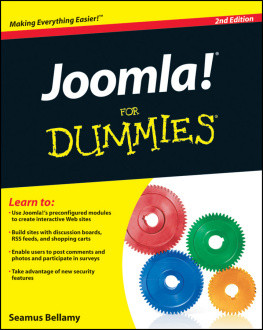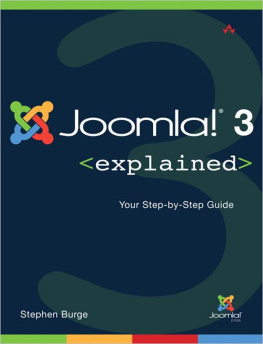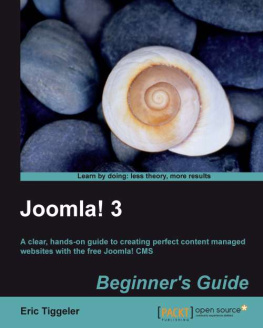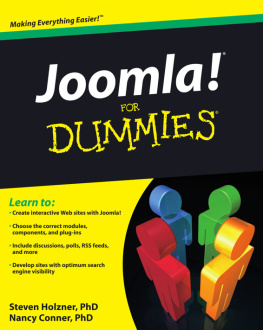Using Joomla
Ron Severdia
Jennifer Gress
Foreword
Ryan Ozimek
Board Member, Open Source Matters (OSM)
In 1999, I found myself in the middle of a war zone, embedded with a humanitarian relief organization in Eastern Europe. I was just another recent college graduate looking for ways to serve a higher purpose. During college, Id paid my way through school by doing database consulting gigs since I had a knack for technology. In the golden era of the dot-comboom, I thought it would be great if there were a way to find affordable, effective, and open sourcetechnology that could be used to help those in need. Flash forward a few years to 2003. As Im preparing to present a website solution to a nongovernmental organization in New York, an engineer on my companys team showed me acontent management system (CMS) called Mambo. At the time, trying to manage content on your website either required an engineering degree or was woefully underpowered to run even a simple blog. Mambo was different. It provided just the right balance of ease-of-use and robustness. Power in simplicity was the tagline. I was hooked.
Little did I know that 11 years later, more than 3% of the Web would be powered by Mambos successor, Joomla. Joomla brought a new way of thinking about website management when it evolved from Mambo in 2005. Website creation and management was no longer the domain of software developers, and instead accidental techies within organizations could now create content on the Web to share with the world. It also brought with it the powerful ability to make your website more than just a blog or content. Third party extensions could be easily added to allow you to sell merchandise, create an online community, and share your message with the world in a variety of new ways.
While Joomla provided liberation from standard technology for accidental techies, its true success was in the growth of a worldwide community of developers, designers, contributors, and users. Bringing diverse backgrounds and cultures to a software project was not novel when Joomla started, but the way it attracted the nonengineer was certainly unique. Due to this community development, Joomla has continued to grow in two directions at the same time, serving the needs of both the average end user and the software engineer.
One of the most striking differences between Joomla and any other software Ive used is its focus on community. From two worldwide conferences each year to more than 40 local conferences spread around the globe, Joomla is truly a community of individuals passionate about harnessing the power of the Internet to improve the world. Its a community that speaks more than 50 languages, is used in more than 190 countries, and which actively promotes and encourages the ideas and contributions of nondevelopers. As the Internet continues to evolve, and as more technology is created to better serve a more global, mobile, and social online world, Joomla continues to change with it.
The book in your hands is a testament to Joomlas progress, as it contains the information you need not only to be successful in building and managing a Joomla website, but also the insight as to where to look for the next generation of technology to help your organization thrive online. Whether youre running a small business or operating a multinational organization, Joomla provides the tools you need to build a successful website. I met Ron at the very firstJoomlaDay event on Googles campus in 2007 and weve been great friends ever since. I also met Jenn at a JoomlaDay (in San Francisco) recently and was immediately impressed by her great attitude, organizational skills, and ability to get things done. Jenn and Ron provide you with a simple step-by-step game plan to create your Joomla websiteand the encouragementto go beyond the basics and explore all the richness the Joomla community has to offer.
I hope to see you in the Joomla community soon!
Preface
Welcome to Joomla!. If youre new to content management systems (CMSs) or even new to building websites, this book will help you get up and running in no time. Whether youre a web designer or an experienced developer, this tome will help you to use Joomla, one of the most popular content management systems available today.
Who Should (and Shouldnt) Read This Book
Have you been asked to build a website in a short period of time? Do you want to convert an existing site to a CMS? Do you have a client who needs a powerful website with lots of functionality? If any of these are true, or you just want to know more about this thing called Joomla that people are talking about, this book is for you.
Wed like to think Joomla is for everyone, but if youre a developer looking to create extensions or build on top of Joomlas framework, this book isnt for you. Its also not meant for those who want to build a static site that rarely needs altering, as Joomla comes with management overhead.
How This Book Is Organized
Each chapter of this book breaks down the extensive features of Joomla into easy-to-understand sections, many with hands-on exercises to help you get going quickly:
Get a little background on Joomla and its history, and a tour of the administrator panel.Planning is number one in most endeavors. Plan your navigation (menus), categories, articles, modules, templates, and more in this planning chapter.Learn how to move around the Administrator Control Panel.Create categories, articles, menus, and modules for your website. Set up your template in this chapter, too.Learn the ins and outs of creating content.Discover how to manage images, files, and videos in Joomla. Learn how to create image galleries as well.The Internet makes a very big world small. Make your website serve content in multiple languages.You, too, can be a writer with your very own blog! Learn how to create a great blog with Joomla.Events are fun for everyone. Keep an events calendar on your site to make your visitors aware of fun events happening in your world.Very few sites exist without forms. Create contact forms or even forms that can accept payments.Sell your wares in an online store in Joomla.Your website needs people. Chapter 12 helps you engage and stay in touch with your visitors in multiple ways.Learn about more lengthy solutions that didnt fit into other chapters, such as SEO, User Groups, ACLs, and more.Keeping your visitors and your website safe is very important. It takes diligence yet isnt difficult.Here youll find step-by-step instructions to install Joomla.Keep your Joomla installation up-to-date and learn how to migrate it, which is sometimes necessary to keep it secure.So many extensions, so little time. Learn how to choose the right extensions for your site. A list of extensions used in this book can be found here.You may want to develop an extension or app with the Joomla Framework. Perhaps youre not a coder and want to get more involved and give back. This is the appendix for you.Little snippets and goodies are here.
Conventions Used in This Book
The following typographical conventions are used in this book:
Italic Indicates new terms, URLs, email addresses, filenames, and file extensions. Constant width Used for program listings, as well as within paragraphs to refer to program elements such as variable or function names, databases, data types, environment variables, statements, and keywords. Constant width bold Shows commands or other text that should be typed literally by the user. Constant width italic Shows text that should be replaced with user-supplied values or by values determined by context.










